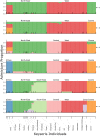An endangered flightless grasshopper with strong genetic structure maintains population genetic variation despite extensive habitat loss
- PMID: 34026013
- PMCID: PMC8131777
- DOI: 10.1002/ece3.7428
An endangered flightless grasshopper with strong genetic structure maintains population genetic variation despite extensive habitat loss
Abstract
Conservation research is dominated by vertebrate examples but the shorter generation times and high local population sizes of invertebrates may lead to very different management strategies, particularly for species with low movement rates. Here we investigate the genetic structure of an endangered flightless grasshopper, Keyacris scurra, which was used in classical evolutionary studies in the 1960s. It had a wide distribution across New South Wales (NSW) and Victoria in pre-European times but has now become threatened because of land clearing for agriculture and other activities. We revisited remnant sites of K. scurra, with populations now restricted to only one area in Victoria and a few small patches in NSW and the Australian Capital Territory (ACT). Using DArtseq to generate SNP markers as well as mtDNA sequence data, we show that the remaining Victorian populations in an isolated valley are genetically distinct from the NSW populations and that all populations tend to be genetically unique, with large F ST values up to 0.8 being detected for the SNP datasets. We also find that, with one notable exception, the NSW/ACT populations separate genetically into previously described chromosomal races (2n = 15 vs. 2n = 17). Isolation by distance was detected across both the SNP and mtDNA datasets, and there was substantial differentiation within chromosomal races. Genetic diversity as measured by heterozygosity was not correlated with the size of remaining habitat where the populations were found, with high variation present in some remnant cemetery sites. However, inbreeding correlated negatively with estimated habitat size at 25-500 m patch radius. These findings emphasize the importance of small habitat areas in conserving genetic variation in such species with low mobility, and they highlight populations suitable for future translocation efforts.
Keywords: Keyacris; fragmentation; grassland; isolation by distance; morabine; small population area.
© 2021 The Authors. Ecology and Evolution published by John Wiley & Sons Ltd.
Conflict of interest statement
None declared.
Figures











Similar articles
-
Long-term biogeographical processes dominate patterns of genetic diversity in a wingless grasshopper despite substantial recent habitat fragmentation.Mol Ecol. 2023 Jun;32(12):3150-3164. doi: 10.1111/mec.16922. Epub 2023 Apr 6. Mol Ecol. 2023. PMID: 36932863
-
Evolutionary history and genetic connectivity across highly fragmented populations of an endangered daisy.Heredity (Edinb). 2021 May;126(5):846-858. doi: 10.1038/s41437-021-00413-0. Epub 2021 Feb 19. Heredity (Edinb). 2021. PMID: 33608651 Free PMC article.
-
No signs of inbreeding despite long-term isolation and habitat fragmentation in the critically endangered Montseny brook newt (Calotriton arnoldi).Heredity (Edinb). 2017 May;118(5):424-435. doi: 10.1038/hdy.2016.123. Epub 2017 Jan 11. Heredity (Edinb). 2017. PMID: 28074844 Free PMC article.
-
Conservation genetics of endangered Trillium govanianum Wall. ex D. Don - A pharmaceutically prized medicinal plant from the Himalaya and implications for species recovery.Gene. 2023 Dec 20;888:147748. doi: 10.1016/j.gene.2023.147748. Epub 2023 Aug 29. Gene. 2023. PMID: 37652171
-
Koala Genome Survey: An Open Data Resource to Improve Conservation Planning.Genes (Basel). 2023 Feb 22;14(3):546. doi: 10.3390/genes14030546. Genes (Basel). 2023. PMID: 36980819 Free PMC article.
Cited by
-
The blowfly Chrysomya latifrons inhabits fragmented rainforests, but shows no population structure.Oecologia. 2023 Mar;201(3):703-719. doi: 10.1007/s00442-023-05333-w. Epub 2023 Feb 11. Oecologia. 2023. PMID: 36773072 Free PMC article.
-
Genome-wide SNPs of vegetable leafminer, Liriomyza sativae: Insights into the recent Australian invasion.Evol Appl. 2022 Jun 28;15(7):1129-1140. doi: 10.1111/eva.13430. eCollection 2022 Jul. Evol Appl. 2022. PMID: 35899255 Free PMC article.
-
Phenotypic characterization and analysis of genetic diversity between commercial crossbred and indigenous chickens from three different agro-ecological zones using DArT-Seq technology.PLoS One. 2024 May 2;19(5):e0297643. doi: 10.1371/journal.pone.0297643. eCollection 2024. PLoS One. 2024. PMID: 38696379 Free PMC article.
-
Genetic assessment and Identification of genes related to characterization of Guangdong local goose breeds based on modern and historical genomes.Commun Biol. 2025 Jul 30;8(1):1132. doi: 10.1038/s42003-025-08550-6. Commun Biol. 2025. PMID: 40738957 Free PMC article.
-
Conservation genetics as a management tool: The five best-supported paradigms to assist the management of threatened species.Proc Natl Acad Sci U S A. 2022 Jan 4;119(1):e2105076119. doi: 10.1073/pnas.2105076119. Proc Natl Acad Sci U S A. 2022. PMID: 34930821 Free PMC article.
References
-
- Allard, R. , & Wehrhahn, C. (1964). A theory which predicts stable equilibrium for inversion polymorphisms in the grasshopper Moraba scurra . Evolution, 18, 129–130.
-
- Allendorf, F. W. , Hohenlohe, P. A. , & Luikart, G. (2010). Genomics and the future of conservation genetics. Nature Reviews Genetics, 11, 697–709. - PubMed
-
- Black, S. H. , & Vaughan, M. (2009). Endangered Insects. Encyclopedia of Insects (Second Edition). Elsevier.
-
- Blackith, R. , & Blackith, R. M. (1969). Observations on the biology of some morabine grasshoppers. Australian Journal of Zoology, 17, 1–12.
LinkOut - more resources
Full Text Sources
Other Literature Sources

